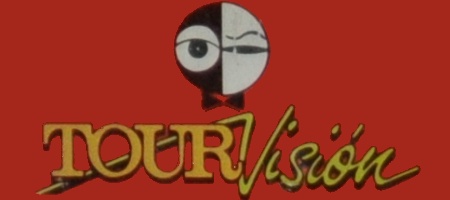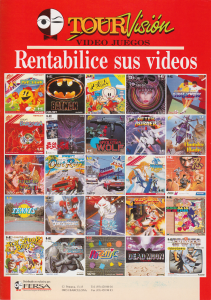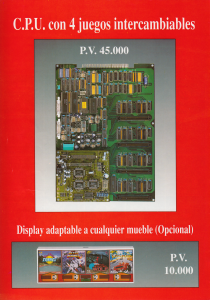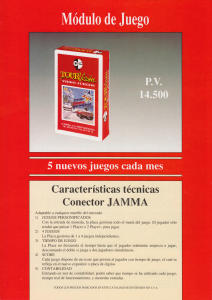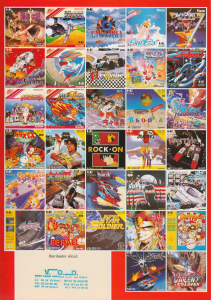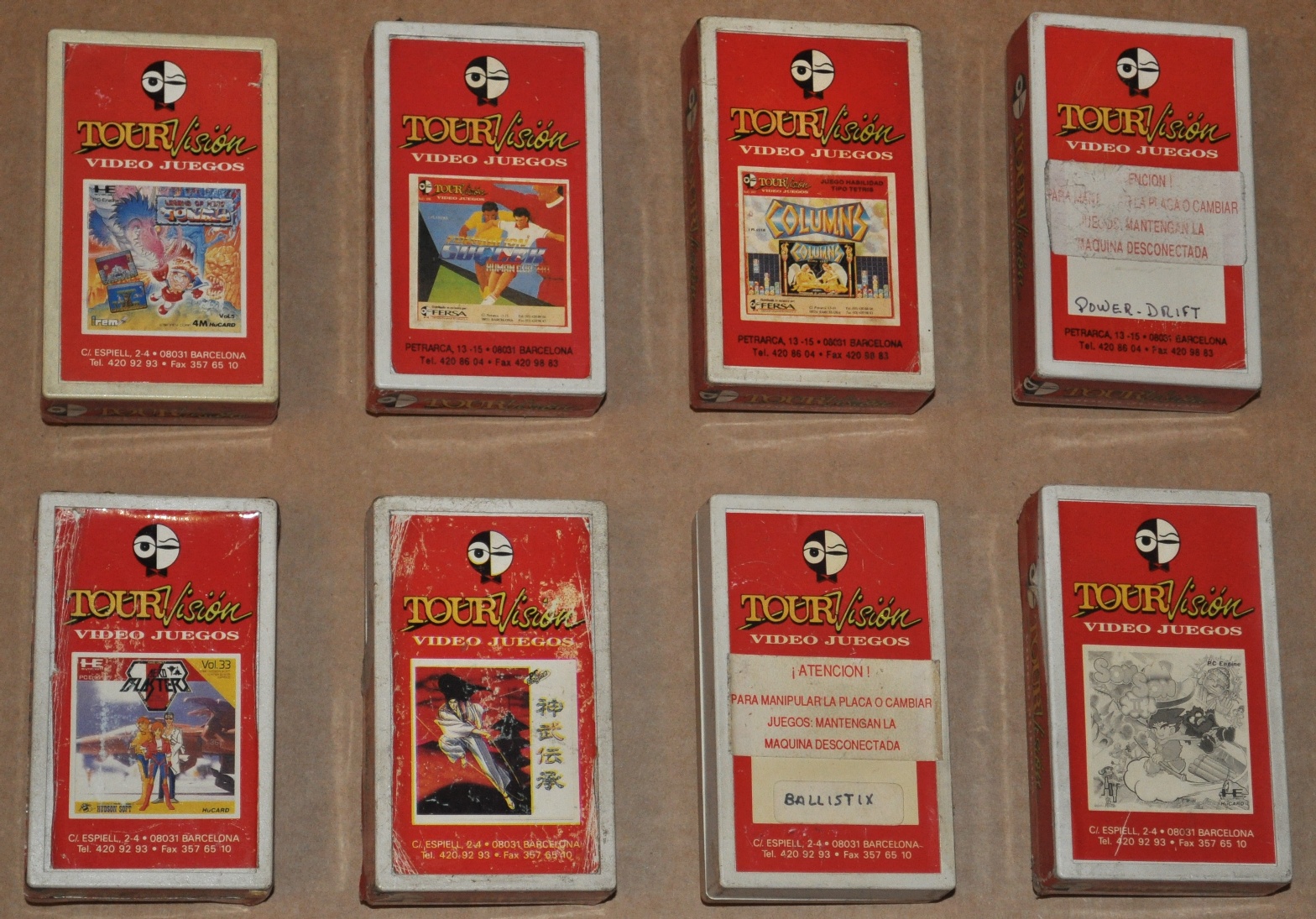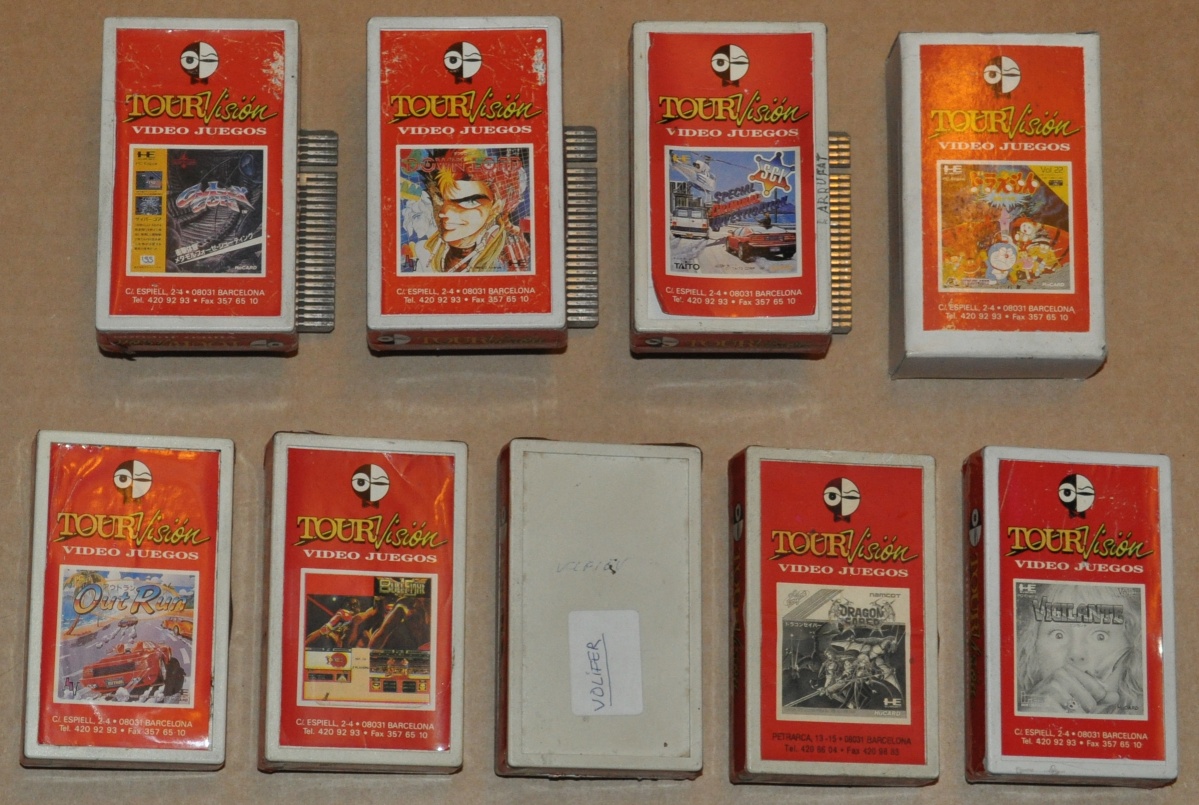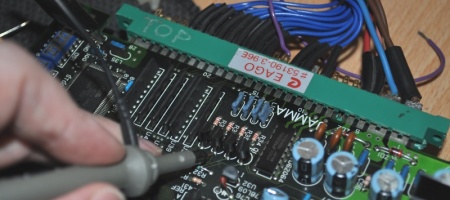(Update 26/08/2017 – revised article to cover newly discovered V1 hardware)
(Update 28/11/2018 – revised V4 integrated photo / description)
(Update 05/02/2018 – flyer added)
(Update 27/03/2018 – score panel discovered)
(Update 18/04/2018 – V1 system with support rail photo)
(Update 23/12/2019 – timer / score info updated)
You may be familiar with TourVision already from the few mentions here and elsewhere, but if you aren’t it’s a Spanish company who made a self-named cart based arcade system, where you can select one of four PC Engine games and buy time to play rather than credits. That makes it similar to the Playchoice and Megaplay systems from Nintendo and Sega, but there are two things that set the TourVision apart.
It’s of dubious legality, and while it started out as something as simple as a Playchoice, it evolved over time.
I’ve heard people say that it was made under license from NEC, and while it’s certainly possible that’s true, what seems rather less likely is that they had a license to be selling all the games available for it. Maybe they didn’t even need one though, we’ll get to that bit later. They were certainly open about it – as this recently obtained flyer shows:
Tourvision V1
With no credit, the system just runs attract mode for whatever game is in the last slot selected (or the first from a cold boot). The player inserts credits and can then use left/right to select the game to play. As soon as they press run the game is selected and the controls unlocked.
Play, die, play again – you have until the timer runs down to do whatever you like, pressing P1 and P2 start together for a moment allows you to go back to game selection.
When time expires the system presses start (“run” in PCE Games, which is sometimes pause or at least a menu), and gives the player a grace period to enter more money. If coins are inserted it restarts the game after a couple more seconds. If no coins are entered, the game is simply reset back to attract mode. It’s quite simplistic, and for example doesn’t stop players unpausing the game during the grace period to get a few more seconds of play before the reset.
As you can see the system is essentially a simple cart switcher, the cartridge slots have no more pins than a standard Hu Card, as you’ll see later in the article. Rather than using support clips as on later versions, the V1 has a bracket support rail to keep the carts from moving around too much, removed in the above photo. The PC Engine is … an actual PC Engine PCB stripped of anything not required, like the power jack, modulator/AV port, etc. It’s connected to the motherboard via a small ribbon cable and a connector row pair, which is how the system presents a game as if it’s an inserted Hu Card.
This is where the V1 board came in incredibly useful for my research – here’s the I/O section. As you can see at one point a development board had adjustment potentiometers for RGBS, but these have been replaced with 0 ohm resistor links for the production model. There are two volume pots since the PC Engine is a stereo console, and the right channel is sent to pins 11 & K on the JAMMA connector. The 4 banks of transistors and resistors are a video amplifier to raise PC Engine RGB output up to arcade spec, and for games which used the PC Engine “select” button, this is mapped to JAMMA button 3.
The connectors are for cabinet functionality, JP105 would go to the marquee and light up the relevant game selection. It simply switches one of four grounds in a 12v circuit suitable for driving lamps – there’s a ULN transistor array doing this switching. JP106 is for the timer display, and based on the timer board from the V4 compared to the hardware on the PCB here, I believe it probably ran a timer in the control panel as well as a single one on the marquee.
It’s not clear how long the V1 system was in service, the game ID (more on this later) for all known V1 games is 65 or below out of 209. The bios is version 2.0 while the earliest known V4 system one is 4.0. I’d imagine the simplicity of the machine and the fact that it allowed players to mess with game options or have to watch their timer tick down during long intro sequences, were flagged as problems by operators. In fact until a few days before this article was amended nobody appeared to know this old revision even existed, and the V1 carts with adapters were simply considered some kind of early rough design.
TourVision V4
Here we can see a partially assembled V4 system. When powered up initially the system will simply pick the first cart and leave it running in demo mode (or the last played), optionally with muted audio if the 8th switch on dip A is active. When you drop a coin in, the 4 digit display shows you an amount of time in seconds, the audio is unmuted and you can then use the joystick to select between games.
However, here’s where the V4 system is a significant departure from other console based arcade time based systems and a huge leap from the V1 – it’s more intelligent and wraps itself around the system and inputs more. When you press start, the game actually resets and then automatically starts, skipping any option menus and so on. The timer will start flashing and then begins counting down once the gameplay starts.
Another V4 improvement are ‘score’ counters for each game which can be seen on the marquee or add-on display units discussed below. A score associated with the chosen game slowly increases during play, one point for every 10 seconds of play, and when the timer runs out that score is consumed 1 point per second as a kind of bonus time period. When the coin timer and any earned bonus ‘score’ are consumed the game is paused and the controls are locked out, the time starts flashing and you have 10 seconds or so to put more coins in or it will reset the system back to attract mode.
And that’s the motherboard, note that in addition to the other upgrades, the system also featured a battery which appears to store credit usage information, and allows the system to suffer a power loss without throwing purchased time away. You can see where the battery would normally fit – this is a Ni-CD cell 3.6v 176mah, part number “3/GF170K” – if you buy one of these boards, remove it. It’s leaking unless someone has already replaced it. The large square button will reset the credits if you power the system up while holding it down. Of the five examples I have, this is the only one without significant acid damage.
Again the V4 is using a stripped down PC Engine motherboard, still think they had an actual license?
The I/O area on the V4 is significantly different, while the stereo audio is retained, the remaining traces of adjustable video are gone, as is the hardware required to drive LED segment displays and drive lamps. JP105 is still used for marquee lighting but additionally carries signals for score and timer display, with the lamp transistor array and digit drivers located on a board behind the marquee.
Three types of score/marquee display exist although they are mostly the same in functionality. The first is a standard marquee display in the dedicated cabinet versions, you can see the V4 cabinet here on recreativas.org, note that unlike the next two it only has displays for the game score counters:
Recreativas.org – Tour Vision video jeux
The next is an optional add on unit which was advertised in the flyers at the top of this article. It’s in a two part metal case and was marketed in Spain and France as you can see from the photo below. Inside the unit is a wooden board and adhesive mini flyers for the games installed could be stuck to this, or as I found poorly taped to the inside of the glass. It seems like only a subset of those game stickers exist as most of the ones I received were just colour copies of the manual cover, it also seems very likely these would have been the same in the dedicated cabinet version.
The third type was an unexpected find and was possibly part of a reduced size cabinet or wall mounted cabinet – I can’t find any images of it outside of the one I own, here’s a photo of the full connected system running:
All three units have individual score (functionally, bonus time) displays for each game and game selection lamps, and the two non-dedicated types also have a display of the remaining time. While the larger units both light an indicator the compact version used small stickers the same as the ones found applied to cartridges, which would have been stuck to the front of the display.
The two 5 display types use the same PCB, looking at the back of this the lamps are easily replaceable with twist holders and we can see an implementation of the circuits removed from the V1 board. I assume the dedicated cabinet version is very similar but lacking the timer display circuits.
JP106 is for the control panel time display, optional on non-dedicated units but essential on the full cabinet. Like the displays above, since the hardware for digit driving is no longer on the V4 motherboard it just has 5v, ground and 3 serial data lines sending the current counter value to this:
Looking at the back of the credit display we can see it’s pretty simple and contains the hardware which used to be present on the V1. For people lacking one I will try to make a schematic at some point.
JP107 is I think supposed to be for a reset button, but on mine grounding the pins like a button doesn’t work even though it looks like it should. Touching the other side of the pulldown resistor with an oscilloscope probe causes the game to totally reset and erase all credits by triggering the NE555 timer. If you look at the cabinet photo in the Recreativas link you can see an additional button at the top of the control panel, my assumption is that’s reset.
And back to the motherboard here are the cart slots, larger than on the V1 as they now control cart switching and perform cartridge identification which we’ll talk about more in my followup article on the BIOS.
Tourvision V4 (integrated)
This is the integrated version of the V4 with the PC Engine components fitted directly to the motherboard, it’s a cleaner design but they seem rather rare and must have been a late development. They seem to use the same BIOS chips as the normal V4.
As you can see comparing to previous photos, they’ve pretty much collapsed the whole PCB level and retained most of the basic component layout, however the op-amp seems to have been removed and the result is noisier audio output from the power amp for similar levels of volume to the standard V4. As such, while this is a nice board in terms of design, I think the previous model has it beaten in actual use.
Game cartridges
On to the cartridges, the discovery of the V1 board answered many lingering questions – there are V1 and V4 carts. V1 have a small connector at one end while V4 have a larger connector along the side. Most V1 carts are found attached to V1 to V4 adapter boards. There is a crossover in the library of titles which are known to exist in both versions, it appears that once V4 was developed adapters were placed on unsold stock or supplied to operators wishing to upgrade. Top image shows a V1 with adapter, bottom is a V4.
Above is the V1 to V4 adapter. The critical difference between V1 and V4 functionality is game specific configuration for starting games, the extra 8 pins on the V4 carts are a binary game ID number. All the adapters do is add those 8 pins to a V1 cart.
Inside the carts they’ve helpfully filled them with epoxy. Thanks guys. I picked two which felt lighter than the rest hoping to find some which hadn’t been filled, no such luck. However one of them betrays how these were made and it might be why I’m not aware of an epic legal battle.
They really are just HuCards sealed in a box, you can make out the Daisenpu artwork along the bottom edge. While it would be different now, back in 1991/2 would it have been illegal in Spain to buy legitimate products from another company and stick them in a case? They’re not bootleg cards – each one represents a sale for the original publisher.
Conclusion
So overall, I actually quite like the system – it’s a native RGB PC Engine you can plug straight into your JAMMA cab without using a real console hooked up to a dodgy looking converter board. On the other hand, it also banishes you from using option menus which is a shame, and you’ll need to use the dip switches to grant lots and lots of time or keep hitting the credit button while playing.
The good thing about the PC Engine aside from the fact that it was clearly a better system than other 8-bit alternatives both in design and performance, was the giant software library. Either the law allowed them to do this or Tourvision just didn’t give a damn, because they brought an awful lot of titles over. In fact I do wonder if they simply ordered the games and converted them on demand, every one of them has been imported from Japan. I’ve been trying to obtain and dump as many as I can, even though the data is the exact same we need to read the game ID bits off them to ever fully emulate the system.
V1 carts with adapters – Xevious, W-Ring (amazing game), 1943 Kai, Saiga No Nindou, Dragon Spirit and Veigues.
Some more V1 games (actually I have a few which are duplicates of V4 carts too) – Override, Dead Moon, Armed-F, Final Blaster, Super Star Soldier and Side Arms which is strangely labelled upside down.
Onto the V4 carts – Dodge Ball, Bomberman, Super Long Nose Goblin (actually Hana Taka Daka), Pac-Land, Mr. Heli, PC Genjin 2, Power Eleven and Raiden. You can see how they got lazier over time with the art.
Jackie Chan, Beisbol 91 (actually Pro Yakyuu World Stadium ’91), Daisenpu, Psycho Chaser, Shinobi, Winning Shot, Gomola Speed and Final Lap Twin. The labels peeling off is very common, in fact I had to stick back down numerous carts when taking these photos.
Legend Of Hero Tonma, Formation Soccer, Columns, Power Drift, Aero Blasters, Jinmu Densho (Wolf Team tried to make a Space Harrier game with a sword..), Ballistix and Son Son II.
On to the boxed ones – worth noting ALL the boxed games I’ve found are the flat type cart. PC Genjin Punkic Cyborg, Toy Shop Boys, Super Foolist Man (hilarious rename of Beraboh Man), R-Type II, Final Match Tennis, Terra Cresta II, Tatsujin and Coryoon with an ugly home made full colour label on the cart.
Skweek, After Burner, Operation Wolf, Devil Crash, Be Ball, Salamander, Gunhed (AWESOME!), and an empty box for Cross Wiber 🙁
And the rest – Parasol Stars II which turned out to be Liquid Kids (disappointing), Ninja Ryukenden, Chuka Taisen re-artworked by the same vandal who ruined Coryoon, Puzzle Boy and KiKi KaiKai.
A few more V1 & V4 which arrived later than the original draft of this article – Cyber Core, Down Load, S.C.I, Doreamon, Out Run, Bull Fight, Volfied, Dragon Saber and Vigilante!
Another batch, 16 more found. Fighting Run, Adventure Island, Spin Pair, Soldier Blade, Mesopotamia (yes the label is upside down), Drop Rock Hora Hora, Tricky and Ordyne.
The NewZealand Story, Super Volley Ball, Image Fight, Puzznic, Power Sports, Kato & Ken (one of my favourite PCE games), Alice In Wonderland and Sokoban World.
V1 carts of Rastan Saga II, Ankoku Densetsu, Batman and Burning Angels. V4 carts of Gradius, Cadash, World Jockey, Dragon Egg and Toilet Kids.
Bomberman ’93, Hit The Ice, Die Hard, Dungeon Explorer, Knight Rider Special, Volfied (replacement of old unlabelled one).
Some duplicates in this next lot I’m afraid – Winning Shot, PC Kid, Columns, Formation Soccer, Puzzle Boy, Dead Moon (V4 version), Bomberman, Daisenpu, Power Sports – these virtually mint condition boxed games came with the integrated motherboard – PC Kid is the unique one not covered above.
I know other games are out there, and I’d be interested in finding better examples of games I already own as well as ones I’ve yet to find. I don’t know if Bloody Wolf was ever sold by the company, but it’s another one I’d really like to find, same with Kato & Ken (update – FOUND!)
Of course it would be possible to make a card reader for the system, and in fact – that’s exactly what someone in France did:
Shame he sacrificed a cart to make it, seems like it would be easy enough to make one from scratch, or at least using a clone of the V1 adapter boards. Cool project though and something I’m tempted to do myself.
So there you go, one of the more interesting arcade curiosities and probably the largest collection of carts. In case you’re wondering, in the last couple of days I dumped and submitted the entire set for inclusion in MAME.
Update – in depth study of the V4 BIOS which I’ve covered in a new post here:
